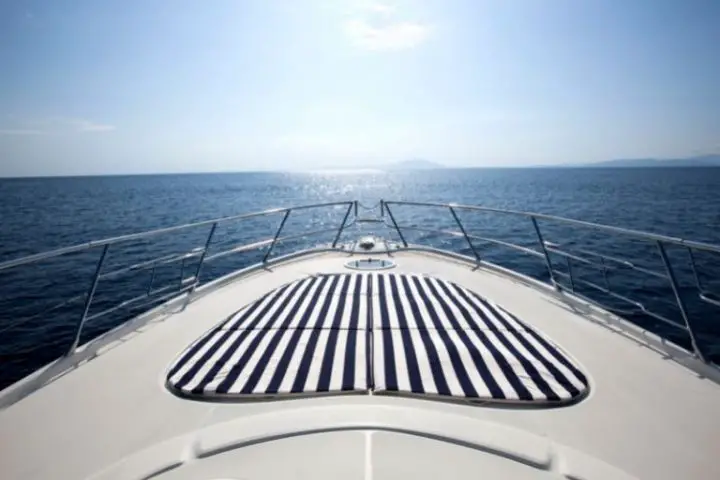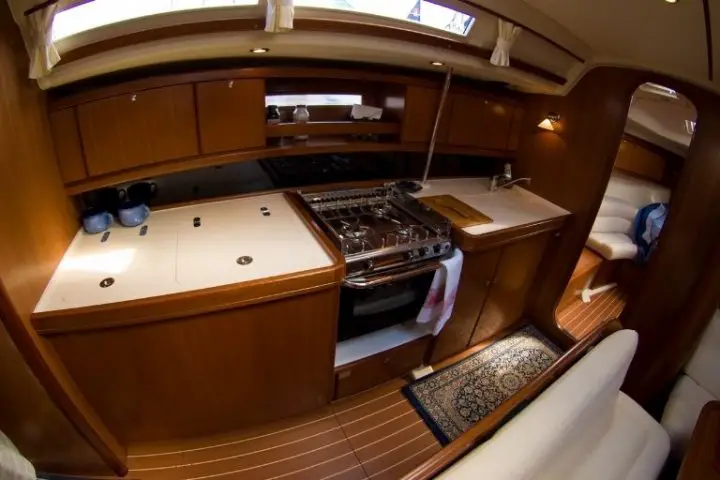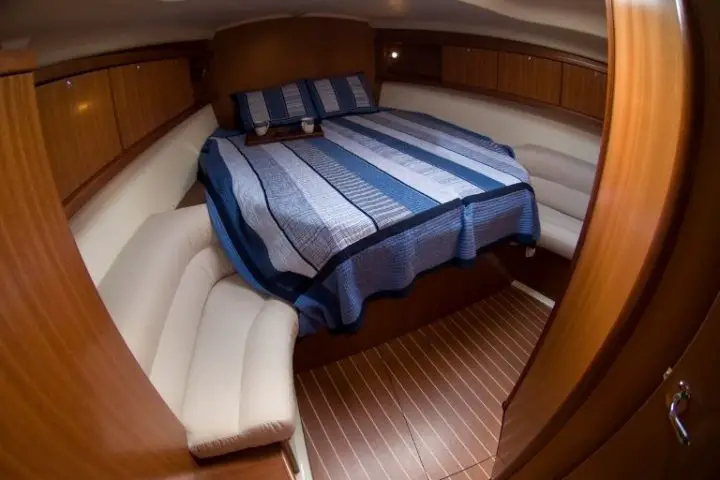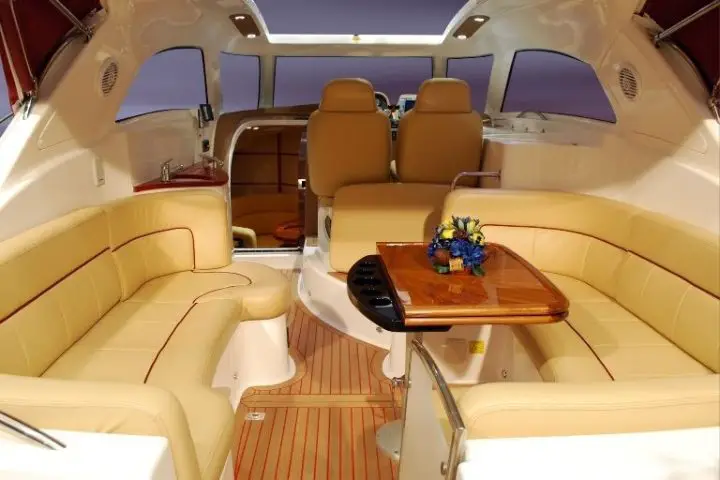There is an undeniable romanticism to the idea of living on a sailboat. Liveaboard sailboats speak to traveling the world, living a slow but rewarding life while going wherever the wind takes you.
Non-boaters are often lured into the lifestyle thanks to online influencers and postcard-perfect voyaging photos. But living on a boat can be challenging, and the wrong boat can make you downright miserable.
No matter what you plan to do with your boat, if you plan to move aboard and live on it, you’ll want to spend some serious time considering your choices. Some boats are much more comfortable than others.

Table of Contents
- Setting Goals for You and Your Boat
- Features to Look for Living Aboard a Sailboat
- Coastal Cruisers vs Bluewater Boats
- Monohulls vs Catamarans
- Are You Sure a Sailboat Is Right for You?
- 10 Great Sailboats for Living Aboard
Setting Goals for You and Your Boat
A wise person once said no single boat has ever been built that was good at everything. Therefore, an essential first step in any boat purchase is to identify precisely what you are really going to do with this boat.
Here’s an example scenario. John, a fictional but accurate sailor, dreams of sailing the “Milk Run” to Tahiti one day. He doesn’t have a way to accomplish this right now because he has a career and bills to pay. But he wants to buy a boat to learn to sail on while he lives at a dock. So the question is, should he buy a boat that can safely and comfortably get him to Tahiti? Or should he save money by buying a smaller, simpler boat that he can live on and sail on his home bay?
There are pluses and minuses for both possibilities. If John buys his big “bluewater baby,” he’s going to spend a lot of money on a dream that he may never achieve. But, on the other hand, he can probably find a perfectly capable live aboard sailboat that will be more fun on his local waters for a quarter of the price of that “bluewater baby.”
If he can save up, retire, and sail off, he’ll probably have figured out a lot more about sailing and make different choices anyway. Few people keep boats for the long haul, they often find that they value designs or features they were completely unaware of when they made their first boat purchase. There are many choices in boating, and it takes years for the best of us to figure out what it is we want.
The point is don’t buy the boat for the “maybe someday” trip of a lifetime until you have an actionable plan to take that trip. Instead, look at what you really will be doing with the boat, and then buy the best boat you can find for that purpose.
Features to Look for Living Aboard a Sailboat
Not all live aboard sailboats are created equally. Some have an aft cabin that is a little more than a glamorous camping tents. Others are palaces of beautiful teak and mahogany joinery, filled with everything needed to keep the crew safe and sound as they circumnavigate the globe.
For now, let’s focus on the single aspect of living aboard. Here are a few of the things you want to take a hard look at when evaluating different vessels.
Headroom
You do not want to live in a boat that you cannot stand up in. For tall individuals, this might mean you have to look far and wide if you’re shopping for smaller vessels. People over about 6’2″ are going to have the most trouble. But keep looking. Hitting your head repeatedly gets very tiresome.

Electrical System
As a liveaboard, you’re going to use your electrical system constantly. Don’t buy a boat with a shoddy electrical system. Electrical fires are one of the most common sources of boat and marina fires. Make sure your surveyor pays extra attention during the survey. You need to have a safe and up-to-standards 120VAC shore power connection. You’ll use this all the time to run basics like your cooking appliances, heaters and air conditioners, and water heater.
Ventilation
Ventilation is essential on boats. It not only provides fresh air for the occupants, but it keeps the air moving in a damp and sealed environment. Without airflow, mold and mildew will quickly take over. Lockers and doors should have vents in them, and there should be deck vents that let the air down below.
Climate Control
Many boats do not have air conditioning or heating appliances. It can be tempting to pass since the point of a boat is to disconnect a little. But living on a boat without these luxuries is nearly impossible in most parts of the world. If you’re going to stay at anchor most of the time, you may be able to get away without AC. But if you’re going to spend any time at a dock, air conditioning is simply a must-have item for most people.
Two things should be noted here. First, most people wind up spending more time at docks than they think they will, so the air conditioner becomes more critical later on. Secondly, air conditioners are costly to install in a boat. Buy a boat with AC installed, and you will never regret it. Buy a boat without it, and you might be very hot, aggravated, and regretful.
Overall Comfort
Look for boats with comfortable living spaces. There are a lot of boats out there that look great in brochures. They have tons of places to sit, tables to work at, or lounges to sun on. But in practice, all of these places are uncomfortably shaped because they are wedged into the boat and have funny angles. Boat makers aren’t interested in making boats that people will live on—they’re interested in making boats that will sell. So the emphasis is usually put on looking good in photos, not necessarily on what is practical.
Privacy
Unless you live alone and plan to stay that way, most boats benefit from some level of privacy. Remember, the smallest boats might not even have a bathroom door! However, larger boats are built with the idea of carrying more people—so you will more likely have private staterooms and more places to get some personal space.
Showers
Most boaters prefer to use the marina’s showers or get a gym membership. But having a dedicated shower on your boat is much more convenient, even if you only use it occasionally. Boats typically have a dedicated shower stall or what is known as a “wet-head.” The wet head is a shared space with the sink and toilet that can be closed off and used as a shower. Sometimes these are larger spaces and work nicely. Other times, it’s a lot of trouble to keep everything dry.
Waste System Capacity and Functionality
Again, many boaters prefer to use the shoreside facilities when possible. But a liveaboard boat needs to have a safe and legal way to contain waste. The holding tank’s size is of extra interest since a small tank may mean frequent trips to the pump-out dock. Also, pay attention to the type of system that is installed—is it the old-style hand pump toilet or an electric flush model?
Some liveaboards like using compact composting toilets. The choice is yours, but you’ll be living with it and maintaining it more than you can imagine until you own your first boat. Keeping it simple and functional is the priority.
Functional Galley
Much like the rest of the boat, boat builders don’t think too much about their galleys’ actual use and functionality. You need one with adequate cabinets and storage space, an easy-to-access fridge, and space on the countertops to cook.
Bed
Most boats come with thin, cheap cushions on the bunks. If you’re going to liveaboard, you need to upgrade your boat beds and get a real mattress. Boat mattresses have all sorts of angles and curves in them to maximize storage space, so it’s not easy to just buy a new one. A custom-cut spring boat mattress will cost thousands of dollars, but you can get a nice memory foam mattress and cut it to fit for a few hundred.

Coastal Cruisers vs Bluewater Boats
In the liveaboard sailboat world, there is a special allure to the bluewater sailboat. Like our fictional sailor John above, many folks dream of setting sail for distant lands.
What exactly makes a “bluewater” sailboat is something of a controversial topic. However, most sailors would point to design like heavy displacement, a comfortable ride and good performance in heavy weather, and robustness of construction not found in most production vessels.
Most things that differentiate a coastal cruiser from a bluewater boat don’t make much difference for living aboard. But many newer coastal cruisers feature wide-open cockpits, low swim-step transoms, and large companionway doors that would not be considered classically “bluewater.” But these features can make a massive difference in the liveability of the space and your overall comfort.
Only one thing is sure—bluewater liveaboard sailboats cost significantly more than regular coastal cruisers. So if you’re not planning ocean passages, you can get a lot more boats for your money by buying a well-equipped coastal cruiser.
An excellent resource for comparing bluewater sailboat designs is Bluewaterboats.org.
Monohulls vs Catamarans
When it comes to purely living aboard, there is no doubt that a cruising catamaran is one of the most comfortable vessels you could choose. They feature an insane amount of living space, and it usually features open patios and salons that are perfect for living and entertaining.
Catamarans are, however, larger and more expensive than monohulls. A few older designs of small catamarans are on the market, some of which are incredibly seaworthy and interesting. But these cheaper catamarans are much closer to living on an uncomfortable monohull than on a beamy and airy charter catamaran.
How Small Is Too Small?
Famous cruising sailors Lin and Larry Pardy’s classic advice to would-be sailors was, “Go small and go now.” It’s important to realize that if your goal is to travel, the vessel matters less than you think. If you’re anchored in a beautiful anchorage in the British Virgin Islands, does the guy on the new Oyster 75 enjoying his sundowner cocktail more than you on your Albin 30? You’re enjoying the same drink, watching the same sunset, in the same idyllic anchorage.
But there are real size limits, of course. For a full-time live aboard couple, most people would agree that a sailboat in the mid-30-foot range is about as small as they’d like to go. Some very beamy designs, like Island Packets, have models in the low 30s that still provide ample space.
After getting aboard a few boats, most people quickly find what their comfortable range is. Some people love their Bristol Channel Cutters homey 28-foot hulls, while others cannot imagine living in anything less than 45 feet. Both answers are probably on the extreme ends.
Pardy’s case for going small still stands, however. As the length of your boat grows, so too do the bills. Sticking with the smallest boat that you can live on comfortably makes the most financial sense.
How Big Is Too Big?
Everything costs more on a bigger boat—slips, maintenance, parts, haul-outs, fuel, sails, etc. Getting a boat too big will quickly sink your budget. It also becomes psychologically too much to handle—too big for a beginner to maneuver at the dock and too many maintenance issues to wrap your head around.
Are You Sure a Sailboat Is Right for You?
For this article, we’re limiting our search to only include liveaboard sailboats. But before you go further in your research, consider carefully—is a liveaboard sailboat the right choice for you?
Most people who cruise on liveaboard sailboats end up motoring far more than they had ever imagined. And liveaboard sailboats come with all sorts of limitations on the living space that powerboats do not have. Liveaboard sailboats are generally narrower and less comfortable. They have more space “down below” with only small portlights, while motor vessels are more likely to have big, comfortable salons with picture windows.
If you’re traveling long distances and plan to sail, you do so for the romantic aspects of the act of sailing. Unfortunately, there is very little money saved by using wind power—for every long passage, there is maintenance and upkeep on the rigging and sails. Yes, you only need new sails and rigging every decade if you take care of them. But $10,000 to $20,000 to replace them will buy a slow motorboat a lot of diesel—up to $2,000 annually!
To travel and liveaboard, speed isn’t the question. Not all motorboats go fast. A boat that planes and goes more than about 12 knots is burning so much fuel and has engines so large that it becomes infinitely more expensive than a liveaboard sailboat.
But a displacement trawler uses an efficient diesel motor and burns only slightly more than a similar liveaboard sailboat under power. Thus, for the loss of the sailing ability, the owner gets fewer systems to maintain and far more living space.
So, how badly do you want to sail? Everything in boating is a give and take. Where does the balance lie for you and your crew?
10 Great Sailboats for Living Aboard
There are so many sailboat designs that no list can be inclusive. They all miss some good ones. The focus here is on designs that have proven themselves comfortable for living aboard. Some are coastal cruisers, and others are truly happy on ocean passages. Some are value-priced “classic plastics,” while others are modern designs that will turn heads at any marina.
Like all the boats, every single design on this list has pros and cons. If there was a perfect boat out there, everyone would be sailing that boat. But there isn’t—we all love different boats for different reasons, and we all value different aspects of their design.

Monohulls
Monohull cruising sailboats have been around for thousands of years. Your search doesn’t need to be that broad, but in the last 60 years, there have been thousands of different designs coming and going. Here’s a look at some boats truly worth a second look.
Island Packet 32 or 320
Island Packets are built with classic features, like a sturdy full keel and a cutter rig. But they are also very beamy, which means a lot of living space in a short-length boat. They also have very shallow drafts compared to other vessels. No matter what size IP you like, expect a boat that feels much larger than its competitors on the inside.
It is also built far better than most other production boats. The 31/32/320 is a popular vessel, and many are available. For more modern features and even more space, check out the 37/370/38/380.
Catalina 30
Probably one of the most popular liveaboard sailboats is the venerable Catalina 30. This boat is small but packs a tremendous amount of living space thanks to its beamy design. Best of all, the 30 was made for decades, so there are plenty to choose from, and many are available for less than $20,000.
There are plenty of other Catalina models that make great liveaboards too. Some of the 40-plus-foot Catalina Morgan designs are venerable offshore cruisers. But, in general, Catalinas are no-frills nearshore cruisers built for weekend coastal cruising.
Hunter 38
Like Catalina, Hunters are coastal cruising production boats. There are lots to choose from, but liveaboards will want to look at those models in the high 30-foot range, like the Hunter 38. Of particular interest is the Hunter 41 or 410.
Beneteau Oceanis 40
Beneteau is the French-made equivalent of Catalina and Hunter—a capable coastal cruiser with plenty of different models to choose from. The most recent two series include the likes of the venerable 423 or Oceanis 40/43. Truthfully, there are so many great designs to choose from on the Beneteau line that you can probably pick any length and come up with a comfortable liveaboard.
Pearson 365
Pearson is a now-defunct production liveaboard sailboat company that put out some great designs. They were wide and tended to have great living space. Like those models listed above, they tend to have a lot of living space. Take a look at the Pearson 365 (ketch-rigged) and the 367 (cutter-rigged).
Islander Freeport 36
Island built strong coastal cruisers in California throughout the 70s and 80s. Many of their best designs came from the drawing board of renowned liveaboard sailboat designer Robert Perry. Some of the best ones included the Islander 36 and the Islander Freeport 36. The Freeport 36 has a gorgeous raised salon and a super comfortable liveaboard layout.
Catamarans
Catamarans offer a tremendous amount of living space, coupled with the spacious feeling of large balcony-like cockpits and huge windows. They cost quite a bit more to purchase and upkeep than the typical monohull, however. They also haven’t been around quite as long, so you are less likely to find older examples to save money on.
Gemini 105MC
The Gemini 105M and 105MC are interesting vessels in that they morph and affordable monohull into a catamaran package. It has a single diesel engine and can fit in most standard marina slips. Yet, it is a shallow draft catamaran that is fun to sail and has a unique living space, including a queen-sized berth and a large bathroom with a shower.
Lagoon 380
Lagoon is a French-based manufacturer of charter and owner catamarans. They built nearly 1,000 hulls of their most famous model, the Lagoon 380, over a 20 year period. These cats are wide and spacious, with a unique and beautiful living space. The galley is up, and there are wrap-around windows. Other good liveaboard options include the venerable 440/450, the older 37, and the new 42.
Fountain Pajot Athena 38
Fountain Pajot’s are similar to Lagoons—French-built production catamarans with similar features, sizes, and build qualities. The older FP Athena 38, Lipari 41, or new Lucia 40 are all wonderful liveaboard catamarans.
Leopard 42
Leopard makes catamarans in South Africa, and they are the supplier for The Moorings charter company boats. Their earliest models, the 38 and the 42/43 are still some of the most sought-after liveaboard cruising cats around. Newer versions of their 39, 40, and 44 have modern and spacious interior, fabulous for living on.
There are dozens of other South African-built catamarans that make wonderful liveaboards. Often, the same boatyard builds similar designs by different names. For example, the Voyage/Maxim/Norseman 380 is a beautiful, well-built catamaran that makes an outstanding liveaboard. The Admiral 38 or 40 are also stellar boats.
To read more about great liveaboard sailboat manufacturers, read our review of the best sailboat and catamaran manufacturers.
